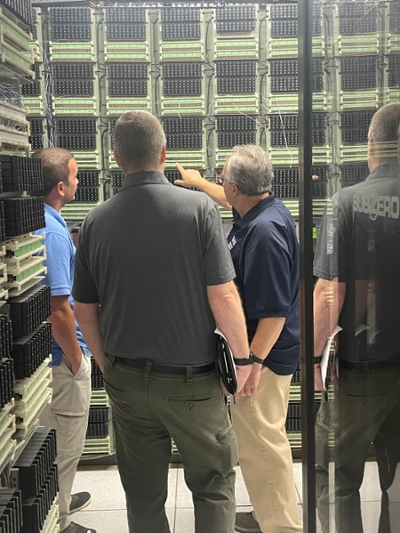IT completes renovation of Blow Hall Data Center and Generator Replacement
More than a decade ago, it was determined that W&M IT would need to upgrade the capability of the existing data center in Blow Hall to house more equipment, provide adequate cooling, and provide reliable backup power. Not only can the center now better handle current needs, but it also stands ready to meet the challenges of the future.
Dave Shantz, infrastructure projects manager, has been working on the project for the past three years and says, “Blow Hall serves as one of the three legged stools that the W&M network depends on (Blow Hall, Jones Hall and Swem Library). Blow is special because it's one of our two primary off campus connections. If Blow does go down, physically or logically, we fail over to secondary backup systems at the School of Education.”

More than half of campus relies on the data center for access to the wireless network. While systems like storage and processors flex between Blow Hall and the Data Center in Jones Hall and should continue operating if Blow were to go down, more than 50 buildings – from Blow to the Wren Building to Zable Stadium and even some of our off campus locations like the Peninsula Center and Discovery buildings in New Town would lose network connectivity.
The renovation included replacing three rows of existing racks with four rows of new racks. They also replaced floor cooling with in-row coolers. Due to the immense amount of heat produced by the server equipment, it is crucial to cool the machinery to avoid systems shutting down or malfunctioning. This is one of the most important pieces of the renovation because we rely on these facilities to run the network and keeping them cool makes the systems last longer and avoid issues. In Blow, there is redundant cooling and power which provides necessary backup systems to make the data center more reliable. These cooling racks keep the cold air inside a confined space to allow for the systems to bring in cool air and let it flow through the machinery.
Built in the early nineties, the Blow Data Center was originally created to house the primary network connection. Network fibers were placed in Blow to supply service to the campus. Additionally, it held the traditional phone lines during its original construction for landline connection. Through the years, it has become a more secondary data location to Jones Hall. Over the years, newer systems have replaced what was kept inside of Blow and moved to Jones. Also, the shift to mobile devices got rid of the need for landline connections. This renovation serves as a means of bringing Blow back to its original status as the primary server for the campus network.
In addition to the renovation of the data center, the other part of this project was installing a very large, very well-specified generator.
 According to Shantz, there are two classes of backup generators: emergency and prime. Emergency generators will see you through a power outage for anywhere between 15 minutes to seven hours. Whereas prime generators can serve as your primary power source for an extended outage.
According to Shantz, there are two classes of backup generators: emergency and prime. Emergency generators will see you through a power outage for anywhere between 15 minutes to seven hours. Whereas prime generators can serve as your primary power source for an extended outage. “When the generator was specified, it was important to the university that, in the case of a hurricane or other event that comes through and we lose power for a week or 10 days, the Blow Hall data center would stay up-and-running,” says Shantz. “The new generator has a larger fuel reserve and a 10-day tank. If it were to run out of fuel, we have reserves on campus we could access for a refill even if the roads might be isolated and we can't get commercial fuel supplies in. Blow's new generator will run seven to 10 days without needing refueling. The Blow Data Center would stay up and still have capabilities in that building that would protect our core essential services.”
Blow Hall has served many different purposes since its original construction. Originally a gymnasium, the location has come a long way. In the coming years, the data center will serve as the primary location for network connection and data storage. The renovation added a lot of extra space to the center for future systems to be added. This will shift the primary location from Jones to Blow thanks to the renovation!
 Skip to main content
Skip to main content
